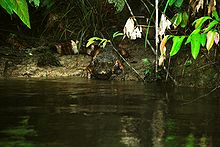Paleosuchus trigonatus
| Smooth-fronted caiman | |
|---|---|
 |
|
| A smooth-fronted caiman at Anaxiqui River in Brazil | |
| Scientific classification | |
| Kingdom: | Animalia |
| Phylum: | Chordata |
| Class: | Sauropsida |
| Order: | Crocodilia |
| Family: | Alligatoridae |
| Genus: | Paleosuchus |
| Species: | P. trigonatus |
| Binomial name | |
|
Paleosuchus trigonatus (Schneider, 1801) |
|
 |
|
| Smooth-fronted caiman distribution (green) | |
| Synonyms | |
|
|
The smooth-fronted caiman (Paleosuchus trigonatus), also known as Schneider's dwarf caiman or Schneider's smooth-fronted caiman, is a crocodilian from South America, where it is native to the Amazon and Orinoco Basins. It is the second-smallest species of the family Alligatoridae, the smallest being Cuvier's dwarf caiman, also from tropical South America and in the same genus. An adult typically grows to around 1.2 to 1.6 m (3.9 to 5.2 ft) in length and weighs between 9 and 20 kg (20 and 44 lb). Exceptionally large males can reach as much as 2.3 m (7.5 ft) in length and 36 kg (79 lb) in weight.
The smooth-fronted caiman was first described by the German classicist and naturalist Johann Gottlob Schneider in 1801. The genus name Paleosuchus is derived from the Greek palaios meaning "ancient" and soukhos meaning "crocodile". This refers to the belief that this crocodile comes from an ancient lineage that diverged from other species of caimans some 30 million years ago. The specific name trigonatus is derived from the Greek trigonos meaning "three-cornered" and Latin atus meaning "provided with" and refers to the triangular shape of the head.
The head of the smooth-fronted caiman is similar in appearance to that of the spectacled caiman (Caiman crocodilus), but no bony ridge or "spectacle" occurs between the eyes. The scutes on the back of the neck and the tail are large, triangular, and sharp. It has heavily ossified body armour on both its dorsal and ventral surfaces. The relatively short tail is broad at its base and flattened dorsoventrally in contrast to most species of crocodilians which have laterally flattened tails. The bony scutes on the tail have sideways projections; and the tail is so well armoured, that it is relatively inflexible. This caiman is a dark greyish-brown with mid-brown eyes. Males grow to about 1.7 to 2.3 m (5 ft 7 in to 7 ft 7 in) long, with the largest recorded specimen being 2.6 m (8 ft 6 in). Females do not often exceed 1.4 m (4 ft 7 in). It is a robust crocodilian, strong for its size, and tends to carry its head high with its neck angled upwards.
...
Wikipedia

